Did you know that you only need five baritone ukulele chord shapes to play major chords all over the neck? If you know a few basic chord shapes, you probably know these five shapes already. The CAGED system is a quick way to remember the shapes and how to use them.
Guitarists commonly use the CAGED system for learning and remembering how to play chords all over the fretboard. And since guitar and baritone uke share the same notes and strings (the four higher-pitch strings), the CAGED system works for baritone uke too.
What Is the CAGED System for Baritone Uke?
CAGED is an acronym that stands for the five basic major chord shapes, as well as the order you need to play them as you move from the nut toward the bridge going up the fretboard. (Going “up” the fretboard means going up in pitch, toward the sound hole.) If you’re new to baritone ukulele, you’ll probably want to learn the basic chords before moving on to the CAGED method. If you’ve already learned the beginner chords, then you already know the five basic major chord shapes:
- C major
- A major
- G major
- E major
- D major
CAGED works for minor chords too on baritone ukulele. In this article, we’ll focus on the major chords.
Why Learn More Than One Way to Play a Chord?
Why bother with the CAGED pattern at all? Why would you need four or five ways to play the same chord? The top reason for beginners is faster, easier, smoother chord changes.
Check out this example:
Most beginners find the F shape to be challenging at first. Changing back and forth between the F shape and another shape, say the A shape, can be even more awkward. But what if you could play both F major and A major with the same chord shape? In fact, you can use the same shape to play E major, F, major, G major, and A major (and more). Here’s how:

Above, we see these four chords played in “first position,” they way we learn them when we first pick up a bariton uke. Below, we see how to play all four chords with the same shape:

The pattern continues all the way to the end of the fretboard. Each fret is a half-step higher in pitch. You won’t need to change the position of your hand and fingers. Just slide your hand up the fretboard one or two frets for each change.
Practice different options for playing chords. You’ll often find that you can solve the awkward chord change problem by using the CAGED patterns.
Learning more than one way to play a chord is also the key to:
- Chord soloing: making a melody out of the top notes that you are playing on your highest strings (E string and B string).
- Bass lines: making a counter-melody out of the bottom notes that you are playing on your lowest string (D string and G string).
- Riffs and runs: add embellishments between chords
- Variety and artistic choices
So let’s get started:
How to Master CAGED for Baritone Ukulele
Here are the steps for major chords:
- Review the five open chord shapes and their moveable versions.
- Learn two best ways to use moveable chord shapes on baritone ukulele.
- Use the five chord shapes with the CAGED pattern for C major.
- Use the CAGED pattern for any major chord on baritone ukulele.
- Check out the CAGED for baritone uke FAQs.
I’ll show you how to use CAGED for minor chords in another post. Same concepts, different shapes.
CAGED for Baritone Uke:
The Major Chords
Tip: Use just 5 shapes to play major chords all over the neck.

Using the color key is optional. Beginners might want to ignore the colors for now.
The colors help you learn the notes and scales that chords are built from. Learn the shapes first, then move on to learning the notes and scales.
1st
position
(open)
chord
shapes
C
open
shape
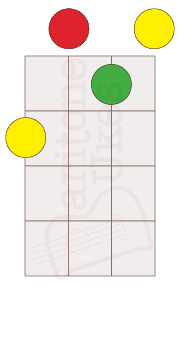
A
open
shape
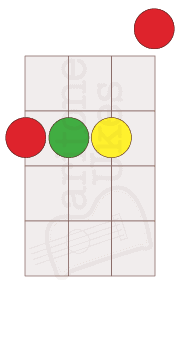
G
open
shape
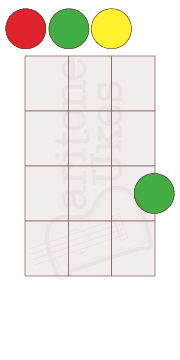
E
open
shape

D
open
shape
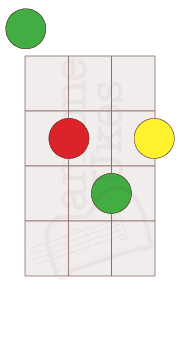
First position or open position means that one or more strings are played without being fretted. The top dots on the above diagrams are “zero fret” or open strings.
Tip: View the entire fretboard diagram below to see how the pattern works all over the neck.
moveable
chord
shapes
C
moveable
shape
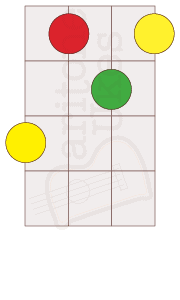
A
moveable
shape

G
moveable
shape
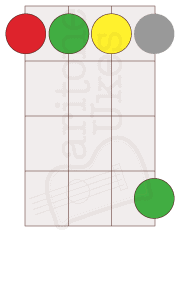
E
moveable
shape
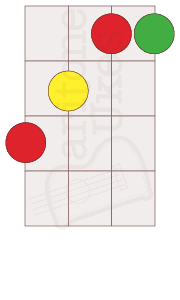
At first, the movable shapes might look different from the open shapes. But take a closer look. They are actually the same shapes, but played on a different fret. The shapes form different chords depending on which fret you play them on.
No matter which fret you play them on, though, they always form a major chord (major triad).
Tip: Barre shapes are the same as the moveable shapes, except for the fingering. The goal is to have options for how you make chords. Then you can choose which works best depending on the chords that come before and after in the song. You can choose to bar a whole fret, or part of a fret. Or you can use separate fingers.

If you’re new to baritone uke, you might want to ignore the colors at first. The colors help you learn the notes that chords are built with. Learn the shapes first, then move on to learning the notes.
* Many people find the moveable D shape to be rather difficult. See the tips below for alternatives.
Two Best Ways to Use Moveable Chord Shapes on Baritone Ukulele
Remember that a major chord shape will always give you a major chord, regardless of where you move it. The chord quality — major, minor, major seventh, dominant seventh, and so on — doesn’t change when you use a moveable shape. The pitch changes (higher or lower), but the relationship between the notes stays the same.
Think of stars in a constellation. The stars of Orion rise in the east, move across the sky, and set in the west, but they always form the shape of the Hunter relative to each other.
There are two ways to use moveable chords on a stringed instrument:
1. Use the same shape on different frets to play different chords. Move the C major shape from the open position to the 2nd fret to play a D major chord. Move the same shape up two more frets to play an E major, and so on.
C to D = 2 frets
D to E = 2 frets
E to F = 1 fret
F to G = 2 frets
G to A = 2 frets
A to B = 2 frets
B to C = 1 fret
2. Change the shape as you change frets to play the same chord in a different way. Play a C major by using the open C shape on the “zero” fret. Or, play a C major by using the A shape on 3rd fret. See the diagram below to use all five shapes to play a C major chord. Use the word CAGED to remember the order.
To play C major using the CAGED pattern:
Use this shape:
C major
A major
D major
E major
D major
To play this chord:
C major
C major
C major
C major
C major
On this fret:
Zero fret (open chord)
3rd fret
5th fret
8th fret
10th fret
This diagram will help you visualize. Better yet, grab your uke and try it:
CAGED for Baritone Uke:
C Major Example
Use the 5 shapes to play C major in five different places
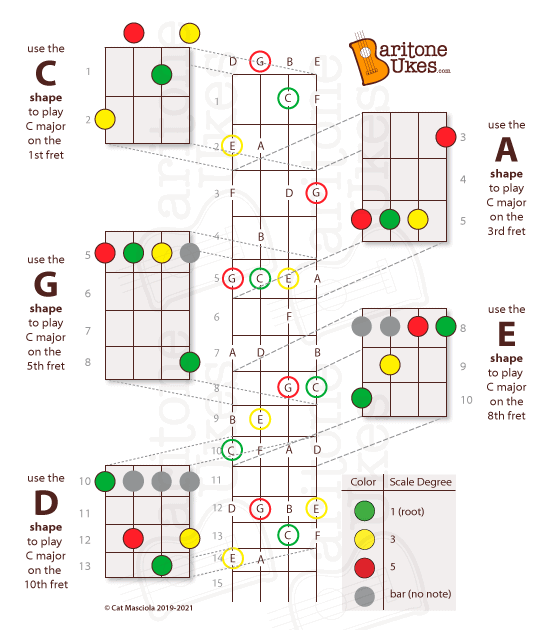
After the D shape, the sequence repeats, beginning with the C shape again.
Dealing with the D Shape
The D shape is fairly easy as an open chord, but rather difficult as a moveable chord. Instead, try the E shape 2 frets lower (toward the nut) or the C shape two frets higher (toward the bridge). Remember that two frets = a whole step. C to D is a whol step. D to E is a whole step.
Use the D shape as an open chord, but focus on CAGE for moveable chords, rather than CAGED.
How to Use CAGED for Any Major Chord on Baritone Uke
The CAGED system lets you play the same chord in different places on the neck, by changing the chord shape and the fret. Work with the patterns, and soon you’ll be able to choose how you want to play a chord, to make quicker chord changes, create chord melodies, move bass lines, and make other artistic choices.
It’s pretty easy to remember the word CAGED to tell you which chord shape comes next. The tricky part of the pattern is knowing which fret is next.
As you get more experienced with baritone uke and start learning about the notes that chord are built with, it will be much easier to know which fret you want because you’ll understand the notes. But in the beginning, you’ll have to use some memorization.
These tips will help you remember:
1. As you spell out CAGED, remember you are moving up in pitch — toward the bridge.
2. After the D shape, continue the pattern by starting again with the C shape.
3. Begin with the open position of the chord you want. For example, let’s say you want to know the options for playing a G major chord on baritone uke. Start with G major in the open position.
4. The next shape you need will correspond with the next letter in the word CAGED. For example, to move from an open position G major to the next option for G major, you change from the G shape to the E shape, because E comes after G in the word CAGED.
5. The same pattern works regardless of which shape you start with. If you’re using a C shape on any fret, the next shape you can use to play the same chord will be the A shape (because A comes after C in the word CAGED).
CAGED for Baritone Uke: FAQs
Don’t see your question answered here? Let me know in the comments below.
Is CAGED the same thing as playing chord inversions on baritone ukulele?
Playing the same chords in different positions on the fretboard means you’re playing chord inversions. A chord inversion means you’re playing the same notes, but they are “stacked” differently. Because the bari uke has only about 15 or so useful frets, you run out “runway” before you repeat the same inversion again. CAGED is five inversions.
Note for theory nerds (like me!): Technically, when the root note of the chord is the lowest note played, the chord is called a root position chord rather than an inversion. The inversions are positions when the root note is not on the bottom. Hence, two of the five shapes above are technically root position chords rather than inversions. Can you spot which two?
Is CAGED the same thing as barre chords on baritone ukulele?
The CAGED pattern includes barre chords and open chords, as well as moveable shapes that sometimes aren’t formed with a barre.
What is the difference between root position and open position on baritone ukulele?
Root position means the root note of the chord is the lowest-pitch note being played, on any chordal instrument. Open position applies only to stringed instruments and simply means that at least one string is not fretted and is played “open.” Take a look at the open position chord shapes above. The green note is the root note. Which of the five open shapes are root position shapes?
What is the Difference Between CAGE and CAGED on baritone ukulele?
Many players find the moveable D shape to be rather difficult. So in practical use, players often use the other shapes and skip the difficult D.
Does CAGED work for minor chords on baritone ukulele?
CAGED does work for minor chords on baritone ukes. CAGED for minor chords is covered in separate post.
What are the best fingerings for inversions on baritone ukulele?
Fingering often depends on the chord sequence. Consider the chords that come before and after, and choose the fingering that works best for the sequence.
What is the difference between moveable shapes and barre shapes?
A moveable shape means you’re fretting all four strings at the same time. Anytime you’re fretting all four strings at once, you have a moveable shape.
A barre shape means you’re using the same finger to fret more than one string at once. If your barre shape is fretting all four strings at once, it’s moveable.
Consider the moveable A shape above. Few beginners can manage this shape as a barre shape. You’d have to be able to use the ring finger to bar the D, G, and B strings without touching the E string. Try it and you’ll see what I mean.
Here’s another example: compare the moveable E shape to the barre E shape. Whether you barre the first two strings or the entire fret depends on the chords that come before and after the E shape.

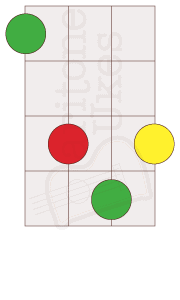
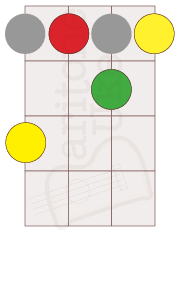
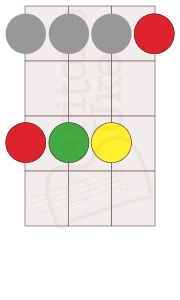
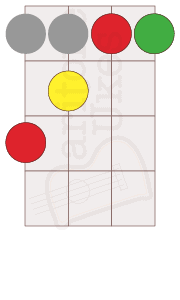
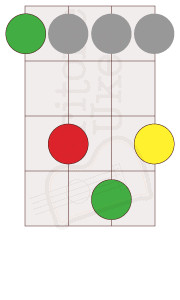


Hi,
Really enjoyed this, very useful but I think you need another fret between the little pinkie and the barre in the earlier G shape examples….this is corrected later
Whoops! Thanks so much or pointing that out. It’s fixed now. I really appreciate when people take the time to help! Glad you found the article useful.